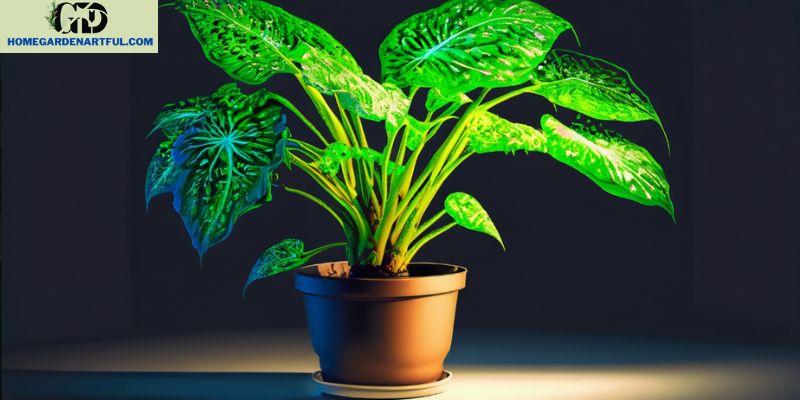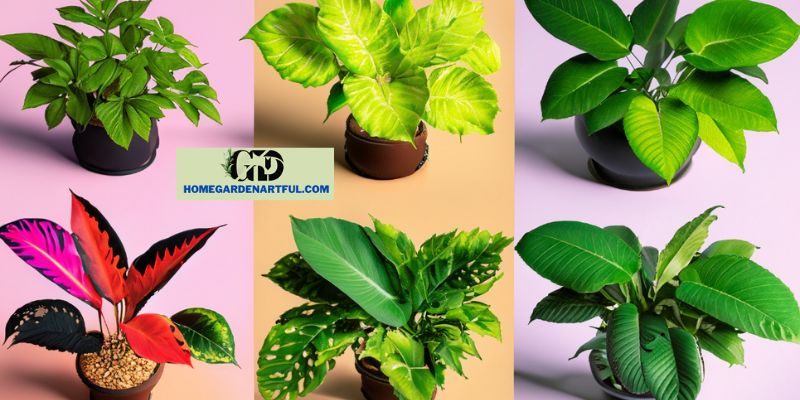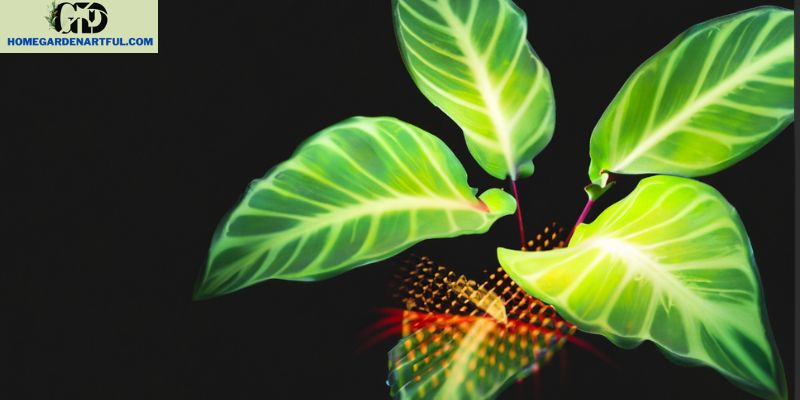Proper lighting is essential for the health and growth of your calathea plants. Understanding and meeting their specific lighting requirements can be a challenge, but with this comprehensive guide, you’ll be well on your way to creating the ideal light environment for your tropical beauties.
In this guide, we’ll cover everything from the basics of calathea lighting requirements to understanding the different light conditions favored by different calathea varieties. We’ll also delve into the effects of excess and insufficient light and provide expert guidance on using grow lights and creating the perfect light environment for your indoor calathea plants.
Key Takeaways:
- Proper lighting is crucial for the health and growth of your calathea plants.
- Understanding the specific lighting requirements of your calathea plants is essential for creating the ideal light environment.
- Different calathea varieties may have specific preferences when it comes to light conditions.
- Excess or insufficient light can be detrimental to your calathea plant’s health.
- Using grow lights can be an excellent supplement to natural light.
Understanding Calathea Lighting Needs

Calathea plants are tropical plants that require specific lighting conditions to thrive. Understanding the lighting requirements of calathea is crucial for maintaining healthy leaves and promoting growth. In this section, we’ll explore the various factors that influence calathea lighting requirements, including light intensity, natural light, and grow lights.
Indirect Light
Calathea plants require indirect light, meaning the light should be filtered or diffused before reaching the plant. Direct sunlight can burn the leaves and cause damage. Therefore, it’s essential to place your calathea in a spot with indirect light. You can achieve this by placing it near a window with a sheer curtain or on a shelf away from direct sunlight. A north-facing window or an east-facing window with a sheer curtain is ideal for calathea plants.
Light Intensity
Calathea plants have specific light intensity requirements to promote healthy growth. If the light intensity is too low, the leaves may turn yellow, and the plant may not grow. If the light intensity is too high, the leaves may burn, and the plant may be damaged. It’s essential to find the right balance of light intensity to ensure your plants are healthy. Calathea plants thrive in low to medium light conditions, and the ideal range is between 1000 to 1500 lux.
Low Light and Grow Light
If your calathea plants don’t receive enough natural light, you can supplement with grow lights. Grow lights are artificial lights that mimic natural sunlight, providing the necessary light for plant growth. Low light grow lights with a blue spectrum are ideal for calathea plants. However, it’s crucial to avoid excess light, as this can damage the leaves and harm the plant. It’s best to provide your calathea with 8 to 12 hours of light per day, depending on the specific variety and lighting conditions.
Natural Light
Providing your calathea plants with adequate natural light is crucial for their growth. However, it’s essential to avoid exposing them to direct sunlight, as this can damage the leaves and harm the plant. Ensure your calathea plants receive enough natural light by placing them in a spot with indirect light, such as a north-facing window or a shaded area in your home. Regularly monitor the light conditions and adjust as needed to ensure your plants are healthy.
Excess Light
Excess light can be harmful to calathea plants, causing damage to the leaves and preventing growth. If you notice your calathea plant’s leaves turning brown or curling inward, it may be a sign of excess light exposure. It’s essential to adjust the lighting conditions by moving the plant away from direct sunlight or adjusting the grow light intensity. Regularly monitoring your calathea’s light condition will ensure its continued health and growth.
Healthy Leaves
Proper lighting is crucial for maintaining healthy calathea leaves. Yellow leaves may be a sign of insufficient light, while brown leaves may indicate excess light. Ensure your calathea plant receives enough light by monitoring their light condition and adjusting as needed. With proper lighting, your calathea plants will display vibrant and healthy foliage.
In the next section, we’ll explore different calathea varieties and their specific light preferences.
Different Calathea Varieties and Their Light Preferences

While most calathea plants share similar light requirements, different varieties may have specific preferences when it comes to light conditions. Understanding the light conditions favored by different calathea varieties will allow you to provide them with the optimum environment to thrive.
| Calathea Plant Variety | Light Preference |
|---|---|
| Calathea Medallion | Indirect sunlight |
| Calathea Ornata | Indirect sunlight |
| Calathea Zebrina | Indirect sunlight |
| Calathea Rattlesnake | Indirect sunlight |
| Calathea Roseopicta | Indirect sunlight |
| Calathea Lancifolia | Indirect sunlight |
| Calathea Makoyana | Indirect sunlight |
| Calathea Insignis | Indirect sunlight |
Most calathea plants prefer bright but indirect sunlight, making them perfect for indoor settings. However, direct sunlight can be harmful to their foliage and cause damage to their leaves. Therefore, it’s best to protect your calathea plants from direct sunlight by placing them in a well-lit area with filtered light.
It’s essential to monitor the light conditions and adjust them as necessary for your calathea plants. With proper care and attention to lighting, your calathea plants will display stunning foliage and remain healthy for years to come.
The Right Amount of Light for Calathea Plants
Calathea plants require specific light intensity levels to maintain healthy leaves and thriving growth. However, too much or too little light can damage the foliage and overall health of the plant. Excess light can cause scorched leaves, while insufficient light can lead to leggy growth and loss of leaves. In this section, we’ll discuss how to find the perfect balance of light for your calathea plants.
Firstly, it’s important to understand the light requirements of your calathea plant. As we discussed in section 2, each variety of calathea can have different light preferences. Some varieties, such as the calathea medallion, prefer indirect sunlight, while others like the calathea ornata can tolerate direct sunlight for short periods. Understanding the light conditions favored by your specific plant will help you provide the right amount of light.
Secondly, monitoring light intensity is crucial for the health of your calathea plants. Too much light can overwhelm the plant and cause damage to the leaves, while too little light can stunt growth and affect the plant’s ability to produce energy through photosynthesis. It’s best to use a light meter to monitor the intensity of light your calathea plant receives. This will help you adjust the lighting conditions to ensure the plant gets the ideal amount of light.
Lastly, it’s essential to maintain proper lighting conditions for your calathea plant. Ensure that the plant is positioned in a location that provides adequate access to indirect light, avoiding direct sunlight. If you’re using grow lights, it’s crucial to maintain the proper distance between the light source and the plant to avoid excessive direct light. Overall, maintaining a harmonious balance of light intensity and condition is critical for ensuring the health and growth of your calathea plant.
Best Practices for Calathea Lighting Requirements
- Understand the light requirements of your calathea plant.
- Monitor the intensity of light using a light meter.
- Ensure proper lighting conditions, providing indirect light and avoiding direct sunlight.
By following these best practices, you’ll be able to maintain the perfect amount of light for your calathea plants, promoting healthy foliage and vibrant growth. Remember to consider factors such as light intensity, excess light, and the specific lighting preferences of your calathea plant for optimal success.
Creating the Ideal Light Environment for Calathea Indoors

If you’re growing calathea plants indoors, it’s important to create an environment that replicates their natural habitat. The right light conditions are essential for your calathea plant’s growth and health.
One of the most crucial factors to consider when growing calathea indoors is providing access to indirect light. Direct sunlight can cause leaf burn and damage, so it’s essential to avoid placing your calathea in direct sunlight. Instead, place it near a window that allows natural light to filter through, or use sheer curtains to diffuse the sunlight.
While calathea plants thrive in indirect light, they still require a certain amount of brightness to grow healthily. If natural light is limited, consider using grow lights to supplement the light conditions. It’s best to use full-spectrum grow lights that mimic natural sunlight.
Proper care and attention to light conditions will promote healthy growth and vibrant foliage for your indoor calathea plants. Make sure to check that the light conditions are consistent and suitable for your calathea’s specific light needs.
Using Grow Lights for Calathea
Grow lights can be an excellent addition to your calathea lighting toolkit, especially if you’re growing your plants in areas with limited access to natural sunlight. Artificial light sources such as grow lights can supplement natural light and help provide your calathea plants with the ideal light conditions they need to thrive.
When choosing grow lights for your calathea plants, consider factors such as the type of light, intensity, and duration. Blue light, which is a type of cool light, is often used in grow lights for calathea because it mimics natural daylight and promotes healthy leaf growth. Bright lights are also suitable for calathea plants, but they should be used carefully to avoid excess direct light which can harm the plants.
To ensure proper lighting, it’s essential to position grow lights correctly. Place the lights at a suitable distance from the plants and avoid placing them too close to prevent damage from the heat generated by the bulbs. Additionally, it’s essential to monitor the duration of exposure to grow lights, as excessive exposure can cause burn marks on the leaves.
It’s essential to ensure that your calathea plants receive the proper lighting conditions for healthy growth. Whether you’re using grow lights or natural light, ensure that your plants receive adequate exposure to indirect or filtered light and avoid exposing them to direct light or sunlight. By giving your calathea plants the right amount of light, you’ll establish the ideal environment for healthy growth and vibrant foliage.
Watering and Light: The Connection
Watering practices can have a significant impact on the health of your calathea plants, particularly concerning their response to light. Tap water, for instance, may contain chemicals that can negatively affect the leaves, causing brown spots and other damages.
To avoid such occurrences, it’s advisable to use distilled water for calathea plants or let tap water sit for a day to allow chlorine to evaporate before using it.
Moreover, how you water your plants and how often can influence how well they respond to light. Overwatering or underwatering can have adverse effects on the plant’s photosynthetic activity and overall health. It’s crucial to check the soil moisture level frequently and water your calathea only when necessary.
By optimizing your watering practices and ensuring the proper light condition, you can promote the healthy growth and development of your calathea plant.
The Role of Light Colors and Spectrum

The color and spectrum of light have a significant impact on the growth and development of calathea plants. Full-spectrum light, which includes all colors of the rainbow and even ultraviolet (UV) rays, is essential for photosynthesis and the production of healthy chlorophyll in plants.
While some studies suggest that exposure to UV rays can damage plant cells and lead to reduced growth, others indicate that proper UV exposure can improve plant resistance to pests and diseases. Calathea plants, which are tropical plants, require a balance of blue and red light for optimal growth and flowering.
When choosing a light source for your calathea plants, consider the spectrum of light it emits. LED grow lights are a popular choice, as they allow you to customize the light spectrum according to your plants’ needs. Additionally, these lights produce minimal heat, prevent excess evaporation, and consume less energy compared to traditional grow lights.
Monitoring and manipulating light color and spectrum can help improve the health of your calathea plants. However, it’s crucial to note that while plants require a balance of different light colors, too much direct light or UV exposure can harm the plant.
Ultimately, providing an appropriate light condition that incorporates the right light colors and spectrum can significantly contribute to maintaining a healthy calathea plant.
Propagation and Light Conditions
Propagating calathea plants requires attention to both light conditions and photosynthetic activity. To propagate calathea through leaf cuttings, start by selecting a healthy leaf from an adult plant. Choose a leaf that is fully grown and free of damage or disease. Cut the leaf at the base of the stem, making sure to keep the stem intact.
Once you have your leaf cutting, it’s important to provide it with adequate light to promote photosynthesis. Place the cutting in a bright, indirect light environment, avoiding direct sunlight. A light meter can help you measure and monitor the light conditions to ensure that they remain at optimal levels for photosynthetic activity.
During the propagation process, it’s crucial to maintain consistent moisture levels. Keep the soil consistently moist but not waterlogged, ensuring that the cutting receives adequate hydration for healthy growth. Overwatering or underwatering can negatively impact the health of the cutting and hinder its ability to establish roots.
With proper attention to light conditions and moisture levels, your calathea leaf cutting should begin to root and develop new growth over time. Once the cutting has developed roots and new leaves, it’s ready to be transplanted into a larger pot. With continued care, your new calathea plant will thrive in its new environment, displaying healthy foliage and vibrant colors.
Best Practices for Calathea Lighting Requirements
Now that you understand the various aspects of calathea lighting requirements, it’s crucial to implement best practices to ensure the proper growth and well-being of your plants. Here are some tips to follow:
- Identify the light requirement: Before purchasing a calathea plant, research its specific light requirements to ensure that it’s compatible with the lighting conditions in your home.
- Use proper lighting: Use a reliable light source that provides the correct light conditions. Natural light, indirect light, or grow light can be used depending on the plant’s light preference.
- Avoid direct sunlight: Direct sunlight can result in leaf scorch, so it’s best to provide your calathea plants with filtered, indirect light.
- Monitor light intensity: Ensure that your calathea plants are receiving the correct intensity of light. Too much light can damage the leaves, while insufficient light can lead to stunted growth.
- Rotate your plants: Rotating your plants every few days ensures that all sides of the plant receive adequate light and prevents leaves from leaning towards the light source.
- Water consistently: Water your calathea plants consistently and avoid letting the soil dry out completely. Consistent watering helps maintain healthy foliage and can prevent leaf curl and browning.
By following these best practices, you can establish a thriving environment for your calathea plants and enjoy their stunning foliage. Proper lighting is crucial for the health of your calathea plants and contributes significantly to their overall growth and well-being.
Conclusion
Providing the proper lighting environment for your calathea plants is essential for their overall health and growth. By understanding the various factors that influence their lighting requirements, you can create an ideal environment for your plants to thrive. Remember to consider factors such as light intensity, indirect light, and the specific preferences of different calathea varieties, as well as the use of grow lights and the role of water quality.
By following the guidelines and best practices provided in this complete guide, you can ensure that your calathea plants are receiving the right amount of light for optimal growth and healthy foliage. Remember to keep a close eye on your plant’s response to lighting conditions and adjust accordingly to meet their changing needs. With proper care and attention to lighting, your calathea plants will display their stunning foliage and thrive in their indoor environment.


